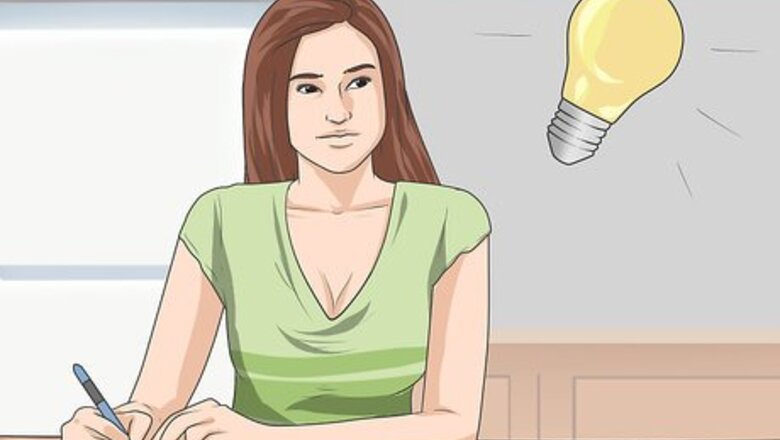
views
Following Your Setup

Brainstorm ideas. Your punchline is your laugh line. Though your audience may laugh throughout your joke, the punchline is the part of the joke that draws the biggest laugh. come up with several potential endings to your joke. Think about what your point of view is. You want to have a unique perspective to your punchline that makes it funny. Write what you know. Use funny experiences or observations from your own life as inspiration. It will take a while to develop a joke. Spend time thinking about what makes your joke funny in the set up. Your set up is when you make a comment on something you find humorous. Your punchline is when you add your personal twist on the topic. Take a look at Jerry Seinfeld’s joke about stain removal products: “Now they show you how detergents take out bloodstains, a pretty violent image there. I think if you’ve got a T-shirt with a bloodstain all over it, maybe laundry isn’t your biggest problem. Maybe you should get rid of the body before you do the wash.” The set up is the first two sentences. Jerry explains what is funny about stain removal commercials. Here he takes a specific point of view and focus on one aspect, bloodstains. The punchline is the last sentence. Jerry ends the joke with a comment on how weird it is that stain removal products use getting bloodstains out of clothes as a selling point.
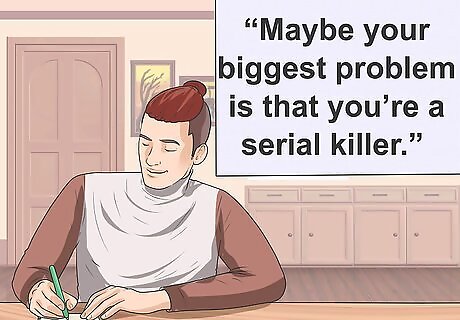
Write out several punchlines. Grab a notebook and a pen and write your set up at the top of your page. Then write down several punchlines for that joke. Try to have a different angle in each one. Don’t censor yourself right now. Instead of thinking too hard on getting a perfect punchline down, free write the first things that come to you. Attempt to keep your punchlines related to your set up. Pick out certain words from your set up to include or build on in your punchlines. Using Jerry’s joke on detergents again, think about what kind of punchlines you might write from the set up. “Now they show you how detergents take out bloodstains, a pretty violent image there. I think if you’ve got a T-shirt with a bloodstain all over it, maybe laundry isn’t your biggest problem.” What could you write to end your joke that calls back to this set up? Maybe you write something like “Maybe your biggest problem is that you’re a serial killer.” Probably not as good as Jerry’s, but that’s why brainstorming and writing out several options helps you. Even though this punchline may not be as funny as the original, it still ties into the set up. It also takes the joke in a different direction than the audience may be expecting. If you need more inspiration, talk to people. Watch movies and documentaries. Read funny books. You can inspiration for jokes all around you.

Make sure your punchline follows your set up. Writing that perfect punchline requires that your set up serves as a story the listener can follow to your punchline. After you’ve written down some punchlines, read over each one and make sure that your set up leads to your punchline. Cross off any punchlines that don’t tie back into your set up. However, if you have a punchline that you really like which does not exactly tie back into your set up, you can rewrite your set up to better serve your punchline. Jokes are fluid and the process for writing great jokes often involves making several edits.
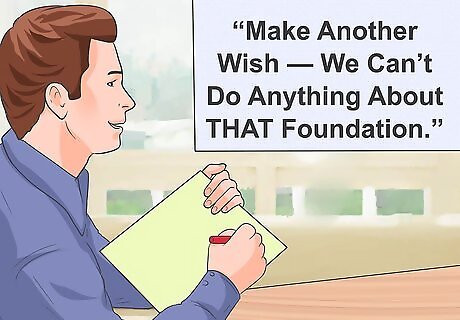
Keep your set up and punchline short. Though many comedians have developed styles of telling jokes which don’t always follow the strict set up to punchline structure, most jokes are relatively short. Your set up should be only a few sentences, in most cases around one or two. Your punchline should be the same length or shorter. Take a look at a Jimmy Carr joke that is two sentences. The set up is one and the punchline is another. “It shouldn’t be called the “Make A Wish Foundation,” should it? It should really be called the “Make Another Wish—We Can’t Do Anything About THAT Foundation.”
Writing Your Punchline
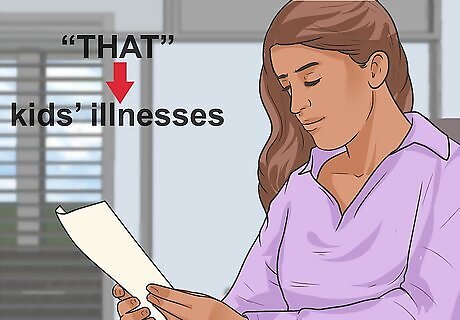
Tighten your joke. Once you’ve decided on one punchline to complete your joke, go ahead and write down the whole joke. Look at how long it is and look for places where you can trim the joke down. Is your set up too long or too short compared to your punchline? Are you including parts of the joke that don’t serve your point of view or make the punchline better? In Jerry Seinfeld’s joke about laundry detergent, think about how much less funny it would be if he added a part about the other functions of laundry detergent. If he talked about the other kinds of stains detergents remove, or how silly the commercials are as a whole, the joke wouldn’t be as funny. There would be about three more sentences in the set up which had nothing to do with the punchline. Additionally, make sure your punchline is about one idea. Look at the Jimmy Carr joke again. The punchline is: “It should really be called the “Make Another Wish—We Can’t Do Anything About THAT Foundation.” Here, the punchline touches on one idea that sums up Jimmy’s point of view. He’s not wasting time giving examples of other wishes or explaining how the first wish the kids would have is to not be ill. His punchline is tight enough that we the audience get what he is saying without him having to explain it. The emphasis on the word “THAT” is funny because we automatically know that “THAT” means the kids’ illnesses, without him wasting time explaining it. Jerry Seinfeld Jerry Seinfeld, Comedian Embrace the journey of pursuing comedy. "The four levels of comedy: make your friends laugh, make strangers laugh, get paid to make strangers laugh, and make people talk like you because it's so much fun."
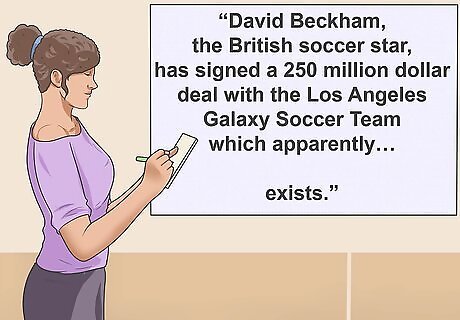
Change course in your punchline. Your punchline can often contain a reinterpretation of what you’ve established in the set up. This is a way to spin your joke or shatter the assumption you have established in your set up. Say you have a joke about something that’s in the news. Here, your set up is like a headline that you might read in the newspaper on a news site. This is often what SNL’s Weekend update does. The anchors on Weekend Update provide the audience with information which is true in the set up. Then the anchor will deliver a punchline which is funny because it takes a left turn and shatters the audience’s assumptions. For example, look at a joke from an actual Weekend Update. “David Beckham, the British soccer star, has signed a 250 million dollar deal with the Los Angeles Galaxy Soccer Team...” This is delivered like a news headline and isn’t funny by itself. Your audience is expecting that you will follow up with some joke about David Beckham, or money, or maybe even a British man moving to America. However, it’s funnier to use your punchline to redirect your audience’s assumptions. Your set up gives you a lot of potential topics to cover. The audience may expect you to go on a tangent about David Beckham. But here, in the actual joke, the punchline takes a bit of a turn: “...which apparently… exists.” Here, the punchline breaks any assumption the audience may have had about what such a deal means. Instead, it makes a comment on how no one in the U.S. knows or cares about one of the world’s most popular sports. Use the 5 W’s to help you find your punchline. Who, What, When, Where, Why, and How. By answering these questions, you will have material to build on and which can help you find an angle your audience may not expect. In this David Beckham joke, trying to answer why he made the deal can lead you to your punchline as your own sense of humor makes you ask why anyone cares about this topic in the first place. Answering the “Who” also helps because whether you like soccer or not, David Beckham is a world famous athlete.

Target your punchline to your audience. Knowing who your audience is will help you write punchlines that land better. You want to have a punchline that your audience can relate to and will find funny. This means that you may have to watch your language if you’re going to perform your jokes in a certain setting or for a certain age group of people. Don’t write a punchline that you know your audience won’t understand. Knowing your audience will also help you to tailor your jokes and punchlines better. This might also make it easier to find a funny punchline. If you’re performing jokes for people in a certain profession, having jokes and punchlines that pertain to that profession will be funnier because those jokes are more relatable.
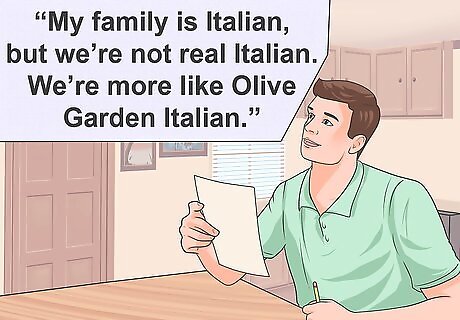
End on a button. While your punchline doesn’t always have to end on the funniest word, it’s good to get in the habit of trying to do so. The punchline, is after all, a punch. It should be quick and snappy and end on the funniest note. Find the punch word. In each punchline, you will have one word which connects to the idea of your joke and is the funniest part. You want that word to be as far back in your joke as possible. Here’s an example from a joke by Mike Birbiglia. “My family is Italian, but we’re not real Italian. We’re more like Olive Garden Italian.” The funniest part of the joke is “Olive Garden Italian”. It’s placed at the very end of the joke because it’s the funniest part and since there’s nothing after it, it gives the audience time to react and laugh. If you continue after the button, you don’t give your audience time to enjoy the joke. Go through your punchline and find the button. If it’s not at the back of your joke, see how you can rearrange the structure of your punchline to end on the button.
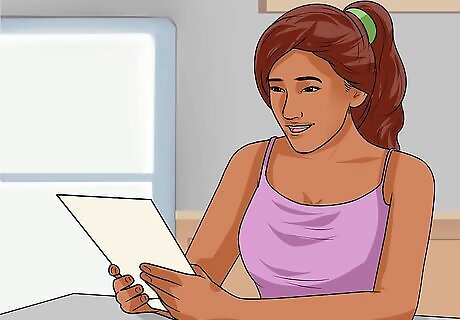
Practice your joke out loud. Read your joke out loud. Find the cadence of it. Part of what makes your jokes, and your punchlines funny will be how you deliver the joke in your own unique voice. See how it feels to read the joke out loud. Check for any parts that seem awkward or drag on too long. Look for any more places that you can trim. Read your joke to your friend and notice where he laughs and if the joke lands. Ask your friend for his opinion on it and see where you can make changes. If you do stand up, record your sets. Play them back after so you know which jokes got a laugh from the audience and which ones didn't. Then you can scrap or develop the jokes that people didn't find funny.
Adding a Potential Topper

Write a second punchline that immediately follows your original one. A topper is an extension to your joke which serves as a second punchline or a funny way to transition to another joke, or add on to your current joke. Your topper is basically your next joke which feeds off of your previous one. You will see this a lot in sets that stand-up comics perform. The topper is meant to help you slowly and naturally move onto a new topic while continuing to get laughs. It’s sometimes written to seem like you like you just came up with it on the spot while performing.
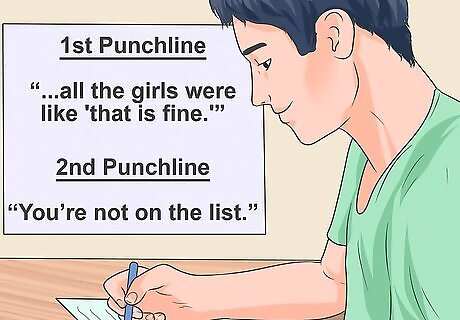
Use a topper to transition into your next joke. Sometimes, a topper can be used to connect your jokes in the form of tags or one liners. Connect the jokes you have written down by adding another punchline. In another Mike Birbiglia set, he talks about kids in middle school starting to make out. He ends the joke by saying “I’m not doing that. And all the girls were like 'that is fine. You’re not on the list.'” Here, the first punchline is “...all the girls were like 'that is fine.'” This punchline ends the first joke and draws a laugh. The topper, or second punchline “You’re not on the list.” Continues the joke, draws a bigger laugh, and lets Mike transition into talking about social cliques in schools based on who is on, or not on “the list”.
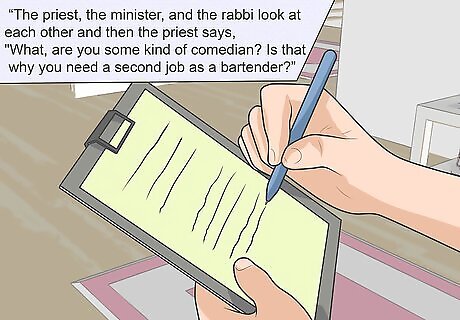
Use a topper to reroute your joke if your punchline doesn’t land. Sometimes your joke won’t land. If that happens, you can write a topper as a backup punchline. Say you have a joke where your punchline doesn’t hit. You have a very simple joke like “A priest, a minister and a rabbi walk into a bar and the bartender says: What is this, some kind of a joke?” You deliver this simple joke and no one finds the punchline funny. You can have a topper in your back pocket to play that continues the joke. It can be as simple as “The priest, the minister, and the rabbi look at each other and then the priest says, "What, are you some kind of comedian? Is that why you need a second job as a bartender?” You can even go further and put yourself in the joke. Oftentimes, what’s funny is when people are capable of self-depreciating humor. Since this topper isn’t all that funny, you can use this opportunity to make fun of yourself. Add a second topper like “For religious figures, those guys did not tip me well. I had to pick up an extra shift to pay rent.” By making fun of yourself and putting yourself in the joke as the broke bartender/comedian, you might create a bit of sympathy from the audience and draw in a laugh.

















Comments
0 comment